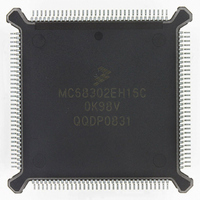MC68302EH16C Freescale Semiconductor, MC68302EH16C Datasheet - Page 72

MC68302EH16C
Manufacturer Part Number
MC68302EH16C
Description
IC MPU MULTI-PROTOCOL 132-PQFP
Manufacturer
Freescale Semiconductor
Datasheets
1.MC68302AG20C.pdf
(4 pages)
2.MC68302AG20C.pdf
(2 pages)
3.MC68302AG20C.pdf
(13 pages)
4.MC68302EH16C.pdf
(481 pages)
Specifications of MC68302EH16C
Processor Type
M683xx 32-Bit
Speed
16MHz
Voltage
5V
Mounting Type
Surface Mount
Package / Case
132-MQFP, 132-PQFP
Controller Family/series
68K
Core Size
32 Bit
Ram Memory Size
1152Byte
Cpu Speed
16MHz
No. Of Timers
3
Embedded Interface Type
SCP, TDM
Digital Ic Case Style
PQFP
Rohs Compliant
Yes
Family Name
M68000
Device Core
ColdFire
Device Core Size
32b
Frequency (max)
16MHz
Instruction Set Architecture
RISC
Supply Voltage 1 (typ)
5V
Operating Temp Range
0C to 70C
Operating Temperature Classification
Commercial
Mounting
Surface Mount
Pin Count
132
Package Type
PQFP
Lead Free Status / RoHS Status
Lead free / RoHS Compliant
Features
-
Lead Free Status / Rohs Status
RoHS Compliant part
Electrostatic Device
Available stocks
Company
Part Number
Manufacturer
Quantity
Price
Company:
Part Number:
MC68302EH16C
Manufacturer:
Freescale Semiconductor
Quantity:
135
Company:
Part Number:
MC68302EH16C
Manufacturer:
PANA
Quantity:
99
Company:
Part Number:
MC68302EH16C
Manufacturer:
Freescale Semiconductor
Quantity:
10 000
Part Number:
MC68302EH16C
Manufacturer:
FREESCALE
Quantity:
20 000
Company:
Part Number:
MC68302EH16CB1
Manufacturer:
Freescale Semiconductor
Quantity:
10 000
Company:
Part Number:
MC68302EH16CR2
Manufacturer:
Freescale Semiconductor
Quantity:
10 000
- MC68302AG20C PDF datasheet
- MC68302AG20C PDF datasheet #2
- MC68302AG20C PDF datasheet #3
- MC68302EH16C PDF datasheet #4
- Current page: 72 of 481
- Download datasheet (2Mb)
System Integration Block (SIB)
Option 2. The external peripheral can generate the vector. In this case the external device
must decode the interrupt acknowledge cycle, put out the 8-bit vector, and generate DTACK.
The decoding of the interrupt acknowledge cycle can be provided by the IACK7, IACK6, and
IACK1 signals (enabled in the PBCNT register) if either normal or dedicated mode is cho-
sen. These signals eliminate the need for external logic to perform the decoding of the A19–
A16, A3–A1, and FC2–FC0 pins externally to detect the interrupt acknowledge cycle. If the
IACK signals are not needed, they can be regained as general purpose parallel I/O pins. The
external device must generate DTACK in this mode, and DTACK is an input to the IMP.
Option 3. The external peripheral can assert the AVEC pin to cause the M68000 to use an
autovector. In this case, DTACK should not be asserted by the external device. AVEC is rec-
ognized by the M68000 core on the falling edge of S4 and should meet the asynchronous
setup time to the falling edge of S4. The IACK signals can be used to help generate the
AVEC signal for priority levels 1, 6, and 7, if needed.
When the IMP generates the vector, the following procedure is used. The three most signif-
icant bits of the interrupt vector number are programmed by the user in the GIMR. These
three bits are concatenated with five bits generated by the interrupt controller to provide an
8-bit vector number to the core. The interrupt controller's encoding of the five low-order bits
of the interrupt vector is shown in Table 3-5. An example vector calculation is shown in Fig-
ure 3-4. When the core initiates an interrupt acknowledge cycle for level 4 and there is no
internal interrupt pending, the interrupt controller encodes the error code 00000 onto the five
low-order bits of the interrupt vector.
3-22
If AVEC is asserted during an interrupt acknowledge cycle, an
autovector is taken, regardless of the vector on the bus. AVEC
should not be asserted during level 4 interrupt acknowledge cy-
cles.
MC68302 USER’S MANUAL
NOTE
MOTOROLA
Related parts for MC68302EH16C
Image
Part Number
Description
Manufacturer
Datasheet
Request
R
Part Number:
Description:
Manufacturer:
Freescale Semiconductor, Inc
Datasheet:

Part Number:
Description:
MC68302 Configuring the Chip Selects on the MC68302
Manufacturer:
Motorola / Freescale Semiconductor

Part Number:
Description:
MC68302 Design Concept - Expanding Interrupts on the MC68302
Manufacturer:
Motorola / Freescale Semiconductor

Part Number:
Description:
MC68302 MC68302 Adapting a WAN Controller to a LAN Environment
Manufacturer:
Motorola / Freescale Semiconductor

Part Number:
Description:
MC68302 EKB Applications - Power Measurements on the MC68302
Manufacturer:
Motorola / Freescale Semiconductor

Part Number:
Description:
MC68302 Interfacing the MC68020 to a Slave MC68302
Manufacturer:
Motorola / Freescale Semiconductor

Part Number:
Description:
MC68302 MC68302 Software Performance
Manufacturer:
Motorola / Freescale Semiconductor

Part Number:
Description:
MC68302 Evaluating EDX on the ADS302
Manufacturer:
Motorola / Freescale Semiconductor

Part Number:
Description:
MC68302 Design Advisory #1 - MC68SC302 Passive ISDN Protocol Engine
Manufacturer:
Motorola / Freescale Semiconductor

Part Number:
Description:
MC68302, MC68360, and MPC860 Characteristics and Design Notes for Crystal Feedback Oscillators
Manufacturer:
Motorola / Freescale Semiconductor
Part Number:
Description:
Mc68302 Integrated Multi-protocol Processor
Manufacturer:
Freescale Semiconductor, Inc
Datasheet:
Part Number:
Description:
Manufacturer:
Freescale Semiconductor, Inc
Datasheet:
Part Number:
Description:
Manufacturer:
Freescale Semiconductor, Inc
Datasheet:
Part Number:
Description:
Manufacturer:
Freescale Semiconductor, Inc
Datasheet:
Part Number:
Description:
Manufacturer:
Freescale Semiconductor, Inc
Datasheet:











